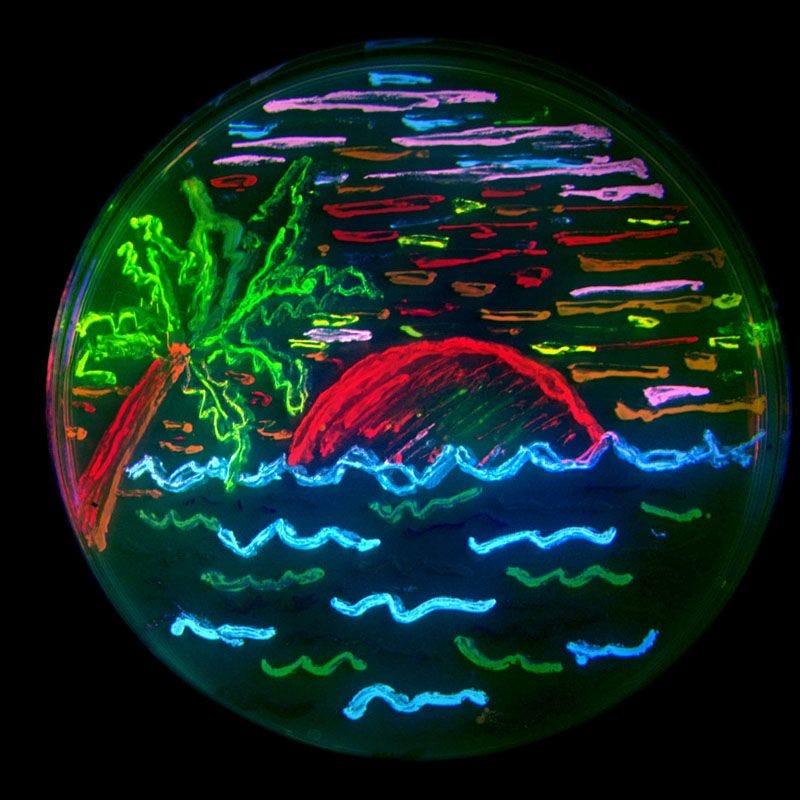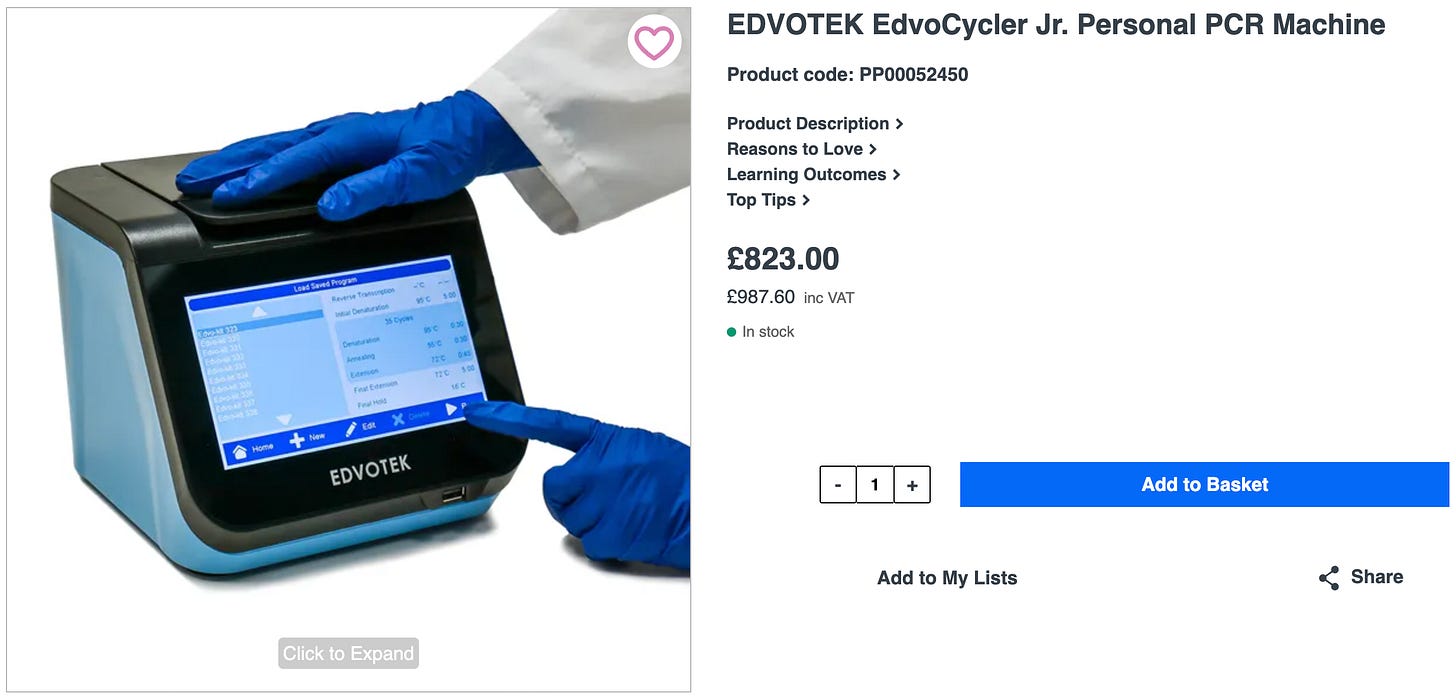DIY Bio Lab #1: The Plan
Pea brain approach to cheap automated bio lab
I stayed at my sister’s place in London a few times over the past couple of weeks to meet people, go to some meet-ups and search for a place to move. There happened to be a couple of biology PhDs staying at their place while I was there and we randomly got chatting about wet lab work. They said a few things that surprised me:
Bio experiments involve a ton of manual labor and often fail for unknown reasons
Daily work involves manually running experiments over and over
Extremely expensive equipment even for simple things like hotplates
It’s hard to replicate anything - everyone uses different equipment
Experiment protocols involve a lot of inexplicit tacit knowledge
See this bio experiment POV for example:
The workflows are surprisingly primitive. An army of PhDs just shuffling test tubes between different stations, constant exposure of reagents and lab equipment to contaminants in the environment and a lot of random heuristics in the protocols.
21st Century DIY Bio Lab
Since I’ve been searching for problems recently, I started to think about how we might redesign bio labs for the 21st Century. The most obvious approach would be to use robots instead of humans that could be programmed to march around and perform the experiments exactly the same way each time. Eg. imagine a robotic arm on a track which could slide around and visit different stations carrying test tubes back and forth.
Performing an experiment would be essentially like executing a program (a sequence of robotic operations) over the same hardware (bio lab equipment). The PhDs would be freed from their manual labor and could focus on more interesting things like proposing new ideas for experiments.
But the cost barrier to entry for this is pretty damn steep. I can hardly afford a single PCR machine, let alone a robotic arm with the level of precision required to operate lab equipment designed for humans!
So I came up with a much simpler/stupider idea - why can’t you just flow stuff through networks of pipes controlled by programmatic syringe pumps and valves? This is already a thing in chemistry (flow chemistry) but it doesn’t seem to really be used in biology. Or at least not in a typical lab.
There are many good things about this approach - it’s more automatable, contamination risk is much lower and everything can be programatically operated with cheap microcontrollers.
You would have to build a bunch of DIY hardware from scratch around this approach. But if you are a hobbyist like me, you are basically forced to do this anyway because traditional equipment is so extortionately expensive - why not make it modern and automatable in the process?
Here’s some more justificatory storytelling about why this is a good idea (take it with an enormous grain of salt):
Cheap Equipment
Improvements in 3d printing (higher precision, ability to print scientific/medical quality materials like PEEK) mean that bio equipment can (in principle) be manufactured extremely cheaply. There are already 3D-printable designs for things like syringe pumps that cost < $40 per pump compared to $2k+ commercial models. If you search DIY <name of biology equipment> you can generally find some attempt online to create a cheap version of the real thing from affordable parts. The main thing that’s missing is to design around automation - which I argue is made significantly easier and cheaper by flowing reactants through tubes - and to write some decent software to glue everything together.
Open Source
Everything could be open source - software could be written to make it literally effortless to set up the equipment even without electrical engineering or programming skills (LLMs mean we are already 80% of the way there). Hardware sheets, automation software and experiment circuit diagrams could be shared and collectively improved by the community.
This would create a huge amount of social value and would be an interesting stepping stone towards new ways of working in bio. It might make bio accessible to more people, especially to bored software engineers looking for a new hobby (like me). Maybe we’ll see more independent bio researchers and startups who can set up their own automated labs outside of academia for < $500 and an increase in the number of undirected tinkerers who can take risks with less capital? Think about how much progress in CS and tech came from having low-cost access to computers.
Why Bother?
Well mainly I am just curious - I want to know whether it’s possible IN PRINCIPLE to create cheap, automated bio lab equipment so I can run some experiments. But suppose it’s possible - it’s not crazy to say that costs could be cut 100x and automated equipment could eliminate a lot of the tacit knowledge required to run experiments or perform bio manufacturing.
This is the exciting part to me - a lot of people care about lab automation and AI in bio, but I think the real value is just in decreasing the capital costs of lab work by 100x and expanding the pool of people who can get involved by 100x.
Next Steps
There are probably a ton of reasons why this is a bad idea. But I already ordered $300 worth of tubes, ESP32 microcontrollers, heat plates, soldering equipment etc. Really I am just writing this as pure copium to console myself that this was not an incredibly stupid waste of money while I wait 10 days for everything to arrive from China.
In the next article I will share my experience wiring things up. My main goal is to be able to run PCR (polymerase chain reaction) in a completely automated way with modular DIY equipment with the ability to optimise over experiment parameters, like the number of PCR cycles or the temperature. If you live in / near London and want to help with the construction, please let me know on Twitter!
And if you don’t hear from me again it’s probably because I electrocuted myself wiring cheap AliExpress hotplates to the mains.







Lovely! Your idea of a "21st Century Lab" reminds me of a few games by Zachtronics, namely SpaceChem, Infinifactory, Opus Magnum, and MOLEK-SYNTEZ. I suggest you check SpaceChem out! But this is a bit of a risky recommendation, I should mention. They might spark new ideas, but these games are, essentially, a dangerously addictive collection of engineering puzzles.